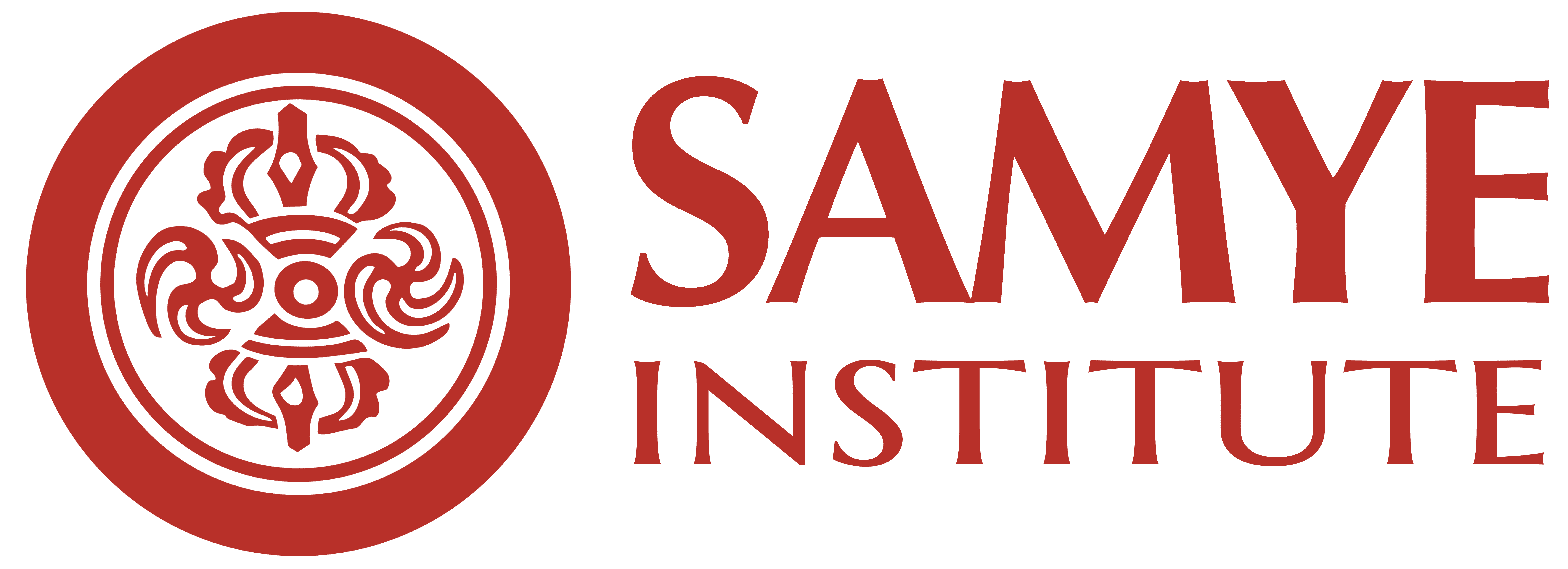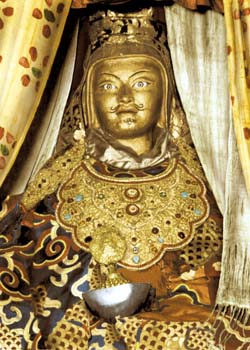Guru Rinpoche, ‘Precious Master’, appears with different names in different contexts. In Tibet, he was famed as Padmasambva, Pemajungné, and Padmakara. These all refer to his origin story, meaning ‘the Lotus-Born’. According to one version of his birth, Buddha Amitabha manifested him from his heart center as the seed syllable HRIH and a golden vajra. These settled on the anthers of a multi-colored lotus flower amid Lake Dhanakosha in Oḍḍiyāna (the modern Swat valley in Pakistan). From these propitious occurrences, Guru Rinpoche took the form of an eight-year-old child, adorned with auspicious signs. The date was the year of the Earth Monkey, on the tenth day of the waxing moon, in the monkey month. Due to these circumstances, he is also known as Tsokyé Dorjé, ‘Lake Born Vajra’.
Tibetans consider him the founder of Tibetan Buddhism and cite predictions attributed to Buddha Śākyamuni of his appearance as the ambassador of the Dharma in the Himalayan region. For this reason, he is often referred to as the “second Buddha”. Guru Rinpoche was instrumental in bringing the Vajrayāna teachings to Tibet. In the Himalayan region, he is famed for taming the local spirits by converting them to be protectors of the Dharma. Invited to Tibet by emperor Tri Songdetsen due to the advice of the Indian abbot Shantarakshita, the tantric master overcame the obstacles to the completion of Samyé monastery.
Namtar or Spiritual Biography in Tibet
References to Guru Rinpoche appear in the Tibetan chronicle known as the Testament of Ba, a manuscript begun by a Tibetan nobleman, Ba Salnang, and updated throughout the imperial period. In the last several decades, scholars have found fragments of copies of this text dating back to the 9th-10th century.1van Schaik, Sam; Iwao, Kazushi (2009). “Fragments of the Testament of Ba from Dunhuang”. Journal of the American Oriental Society. 128 (3): 477–487. Guru Rinpoche’s life story is expanded in a number of different texts beginning in the 12th century. The earliest namtar is the Namtar Zanglingma, ‘The Jeweled Rosary Story of Liberation’ by Nyangrel Nyima Özer.2English translation, The Lotus-Born: The Life Story of Padmasambhava, recorded by Yeshe Tsogyal, transl. by Erik Pema Kunsang, Rangjung Yeshe Publications. This was discovered as a hidden terma at the Copper Temple at Samye monastery. The second and most popular source is the Pema Kathang (the Chronicles of Padma which is also known as the Namtar Sheldrakma) ‘The Life-Story from the Crystal Cave’ revealed in the 14th century by Orgyen Lingpa.3English translation of the full-length Pema Kathang, Yeshe Tsogyal, The Life and Liberation of Padmasambhava, Vol. I & II (Emeryville: Dharma Publishing, 1978). A summary is available under the English title A Beautiful and Wondrous Udumbara Garland by Jamyang Khyentsé Wangpo. Orgyen Lingpa also revealed the Kathang Dénga ( Five Chronicles) that relates the story of the Dharma’s arrival in Tibet.
Incarnations
According to the Condensed Pema Kathang, an abbreviated biography also revealed by Orgyen Lingpa, Guru Rinpoche delivered this explanation of his Tibetan incarnation:
Previously, I have been the Buddha of Infinite Light, Amitābha, the Protector Avalokiteśvara of Mount Potala, and Padma Jungné of Dhanakośa. Although these each arise as the expression of the three kāyas, they are ultimately inseparable and indivisible.
Abiding in the dharmadhātu is Samantabhadra; in Ghanavyūha is the great Vajradhara; and in Bodhgaya is the Great Sage himself. [Śākyamuni] Inseparably, they are all spontaneously accomplished within myself, Orgyen.
Therefore, always pray to me!
A Concise History of Orgyen Padma’s Enlightened Deeds by Orgyen Lingpa, trans. Samye Translations.
Thus, Tibetan Buddhists feel particular devotion to Padmasambhava, whose image is often given the principal place of honor in temples throughout the Himalayas. Most Tibetan Buddhists know by heart the yearning supplication prayers that call upon Guru Rinpoche for blessings. The most famous of these is the Seven Line Supplication to Padmasambhava, a treasure revelation by Guru Chökyi Wangchuk. Phakchok Rinpoche has explained the history of this supplication and commented:
The Seven Line Prayer refers to the outer guru, who is symbolized or represented by the manifestation of Guru Rinpoche in a physical form. However, when we talk about the ‘guru’, there are actually different levels of meaning, such as outer, inner, and secret. In terms of the inner and the secret meaning of the seven-line prayer, emptiness and co-emergent wisdom respectively are manifested.
Twelve Manifestations
In the terma teachings of the Chokling Tersar’s Tukdrup Barché Kunsel, Guru Rinpoche manifests in twelve ways to tame and benefit beings. These manifestations and their activities are invoked to remove all obstacles in the well-known supplication prayer, The Prayer Which Removes All Obstacles from the Path, or the Barché Lamsel. This treasure was revealed by Chokgyur Dechen Zhikpo Lingpa. Phakchok Rinpoche has offered short teachings on each of these manifestations.
In our own present world age, one thousand Buddhas will appear. Each one will be accompanied by an emanation of Guru Rinpoche to carry out the Buddha’s activities. In the present age of Buddha Shakyamuni, all the Buddha’s activity appeared in one emanation in the form of Padmasambhava, the Lotus-Born One. Padmasambhava lived for a very long time. After his birth, he continued living in India for about one thousand years. Afterward, he arrived in Tibet and remained there for fifty-five years. Before Padmasambhava left Tibet, he made many predictions, hid many teachings to be revealed in the future, and blessed his close disciples to be inseparable from him. In this way, they would reincarnate in the future, reveal the hidden teachings, and be as powerful as Guru Rinpoche himself. In particular, he prophesied the coming of 108 great tertöns, ‘hidden-treasure revealers.’ World history fluctuates, causing particular difficulties to arise at different times. Having foreknowledge of these historic intervals, Guru Rinpoche designed special practices that specific tertöns would reveal at the appropriate times, in order to aid human beings. The tertöns discovering these termas, or ‘hidden treasures,’ would then give a totally fresh, up-to-date teaching meant for that specific time and situation.
Tulku Urgyen Rinpoche in Dispeller of Obstacles: The Heart Practice of Padmasambhava, trans. Erik Pema Kunsang, ed. Marcia Dechen Wangmo. Rangjung Yeshe Publications: Hong Kong, 2014
The essence of all the buddhas of the three times, the supreme sovereign of all power-wielding vidyadharas, the all-encompassing lord of the ocean of peaceful and wrathful yidams, the chief of the gatherings of all the dakas and dakinis, the great being who by his splendor outshines all the vajra protectors of the Dharma and the haughty forces of appearance and existence, is the one renowned throughout the infinite realms of the teachers of the three kayas as Mahaguru Padmasambhava.
Light of Wisdom, Vol. I, translated by Erik Hein Schmidt, Rangjung Yeshe Publications.


